-
 Bitcoin
Bitcoin $107,725.9156
0.27% -
 Ethereum
Ethereum $2,481.6786
1.84% -
 Tether USDt
Tether USDt $1.0003
0.01% -
 XRP
XRP $2.2154
1.26% -
 BNB
BNB $658.2447
1.42% -
 Solana
Solana $157.2028
4.24% -
 USDC
USDC $1.0000
0.02% -
 TRON
TRON $0.2788
0.91% -
 Dogecoin
Dogecoin $0.1655
1.00% -
 Cardano
Cardano $0.5714
2.67% -
 Hyperliquid
Hyperliquid $40.6187
6.30% -
 Bitcoin Cash
Bitcoin Cash $519.8117
5.84% -
 Sui
Sui $2.8338
0.59% -
 Chainlink
Chainlink $13.4150
0.60% -
 UNUS SED LEO
UNUS SED LEO $9.1205
-0.54% -
 Avalanche
Avalanche $18.0666
0.85% -
 Stellar
Stellar $0.2363
-0.46% -
 Toncoin
Toncoin $2.9550
2.57% -
 Shiba Inu
Shiba Inu $0.0...01151
-0.15% -
 Litecoin
Litecoin $86.2252
-0.57% -
 Hedera
Hedera $0.1498
1.51% -
 Monero
Monero $318.0620
3.18% -
 Polkadot
Polkadot $3.4174
-0.02% -
 Dai
Dai $1.0000
0.02% -
 Bitget Token
Bitget Token $4.5444
-1.05% -
 Ethena USDe
Ethena USDe $1.0003
0.00% -
 Uniswap
Uniswap $7.1773
-0.53% -
 Pepe
Pepe $0.0...09916
3.19% -
 Aave
Aave $274.7399
0.32% -
 Pi
Pi $0.5136
-2.06%
Can the three consecutive positive lines at the bottom but insufficient volume confirm the trend reversal?
Three green candles at a downtrend's bottom may hint at a reversal, but without rising volume and technical confirmation, the rally often lacks sustainability.
Jun 30, 2025 at 09:28 pm
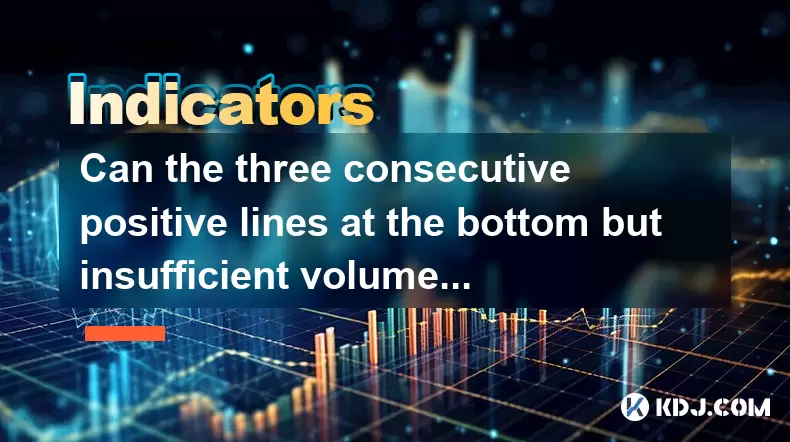
Understanding the Context of Three Consecutive Positive Candles
In technical analysis, observing three consecutive positive lines (candles) at the bottom of a downtrend can raise questions about a potential trend reversal. These candles typically indicate that buyers have started to exert pressure after a prolonged decline. However, merely seeing these bullish candlesticks is not sufficient evidence on its own to confirm a trend reversal.
The formation often appears as a reversal pattern, especially if it emerges after a strong bearish move. Each candle closes higher than the previous one, suggesting increasing buying momentum. Still, volume remains a critical factor in validating such patterns. If the volume during these three days does not show a significant increase compared to the average volume of prior sessions, it may indicate weak participation from institutional players or major market participants.
The Role of Volume in Confirming Reversals
Volume plays an essential role in confirming any technical signal, including trend reversals. A genuine reversal usually involves a shift in sentiment that attracts new buyers or encourages sidelined investors to enter the market. This shift should be reflected in rising trading volume.
When analyzing the scenario where three positive candles appear but volume remains low, caution is necessary. Low volume could suggest that the rally is being driven by retail traders rather than institutional money. In such cases, the upward movement may lack the strength to sustain itself and could easily reverse once selling pressure returns.
To assess this more accurately:
- Compare the volume of the three bullish days with the average volume over the last 20 trading sessions.
- Look for signs of accumulation, such as decreasing volatility or smaller red candles before the green sequence.
- Check if key support levels align with the price action.
Identifying Supporting Indicators and Patterns
Relying solely on candlestick patterns and volume is risky. Traders should incorporate other indicators to validate the possibility of a trend reversal. Popular tools include:
- Moving Averages (MA): A bullish crossover of short-term MAs (e.g., 9-day crossing above 21-day) near the bottom can strengthen the case for a reversal.
- Relative Strength Index (RSI): An RSI rising from oversold territory (below 30) toward 50 suggests improving momentum.
- MACD: A MACD line crossing above the signal line can provide additional confirmation.
These tools help filter out false signals and enhance confidence in the observed price behavior. It's also beneficial to look at multiple timeframes — for example, checking weekly charts to see if the asset is still in a long-term uptrend despite short-term weakness.
Examining Historical Precedents in Crypto Markets
In the context of cryptocurrency markets, which are known for their high volatility and emotional trading, three green candles at the bottom are common during recovery phases. However, due to the speculative nature of crypto assets, many such rallies fail without proper volume backing.
For instance, during Bitcoin’s sharp correction in mid-2021, several small rallies appeared with little volume, only to be followed by renewed selling pressure. Conversely, when BTC rebounded strongly in late 2022, each leg up was supported by expanding volume and positive macro developments.
Historical chart analysis shows that low-volume rallies tend to underperform in terms of sustainability. Therefore, while the presence of three bullish candles might indicate early interest, they should not be interpreted as a confirmed reversal unless supported by volume and broader technical alignment.
Practical Steps for Evaluating the Scenario
If you're assessing whether three consecutive green candles at the bottom with insufficient volume indicate a real trend reversal, follow these practical steps:
- Confirm the Downtrend Context: Ensure the asset has been in a clear downtrend before the three candles appeared. A consolidation phase before the rally doesn’t count as a downtrend.
- Measure Candlestick Quality: Are the candles showing strong closes? Do they have small wicks or large bodies? Strong-bodied candles suggest conviction.
- Check Volume Relative to Average: Use a 20-period volume moving average. If none of the three days exceed this average, it indicates weak participation.
- Observe Price Behavior After the Pattern: Does the price continue to rise beyond the high of the third candle? Or does it immediately retrace?
- Combine with Other Technical Tools: Use RSI, MACD, and moving averages to cross-validate the potential reversal.
By systematically applying these checks, traders can avoid premature entries and better assess whether the pattern is likely to lead to a meaningful trend change.
Frequently Asked Questions
Q: Can three green candles at the bottom ever confirm a reversal without volume?
While it’s possible for short-term bounces to occur without volume, sustainable trend reversals almost always require increasing volume. Without it, the rally lacks institutional backing and is more prone to failure.
Q: How long should I wait to confirm a reversal after seeing this pattern?
There is no fixed timeframe, but watching how the price behaves in the next 3–5 sessions is crucial. If the price breaks above the high of the third candle with increased volume, it strengthens the reversal case.
Q: Should I ignore the pattern entirely if volume is low?
Not necessarily. You can treat it as a potential early sign of a reversal but avoid full commitment until further confirmation comes through volume and price continuation.
Q: Are there specific cryptocurrencies where this pattern works better?
This pattern applies broadly, but it tends to be more reliable in larger-cap cryptocurrencies like Bitcoin and Ethereum, where volume data is more robust and less susceptible to manipulation.
Disclaimer:info@kdj.com
The information provided is not trading advice. kdj.com does not assume any responsibility for any investments made based on the information provided in this article. Cryptocurrencies are highly volatile and it is highly recommended that you invest with caution after thorough research!
If you believe that the content used on this website infringes your copyright, please contact us immediately (info@kdj.com) and we will delete it promptly.
- Coinbase, Altcoins, and Listings: What's the Buzz?
- 2025-07-01 00:30:11
- Chainlink's Bullish Signals: Investors Bet on Long-Term Value
- 2025-07-01 00:50:12
- Bybit, Kraken, and Tokenized Stocks: A New Era for Trading?
- 2025-07-01 00:30:11
- MicroStrategy, S&P 500, and Crypto News: A Wild Ride for Bitcoin and Beyond
- 2025-07-01 00:55:11
- Week Review: Neo Updates, Crypto Market Movers, and the Stablecoin Evolution (June 23-29)
- 2025-07-01 01:00:12
- Crypto.com & dYdX: Derivative Trading Revolutionized for Everyone
- 2025-07-01 00:35:12
Related knowledge
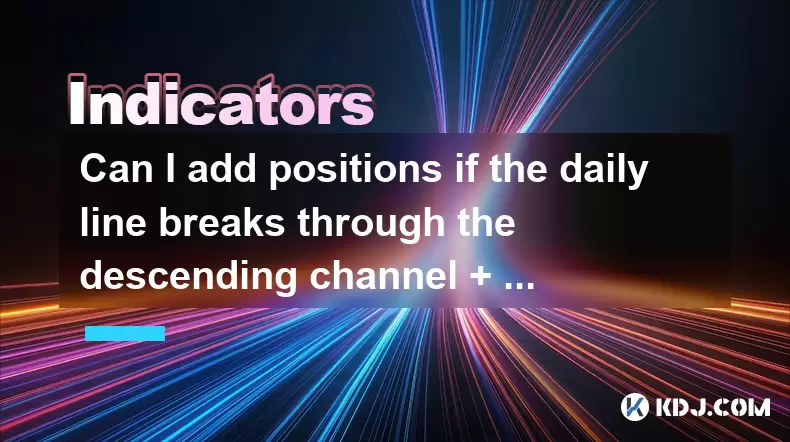
Can I add positions if the daily line breaks through the descending channel + the 30-minute moving average is in a bullish arrangement?
Jun 30,2025 at 11:00pm
Understanding the Descending Channel BreakoutWhen a daily line breaks through a descending channel, it indicates a potential shift in market sentiment from bearish to bullish. A descending channel is formed by drawing two parallel trendlines, where the upper trendline connects the lower highs and the lower trendline connects the lower lows. A breakout o...
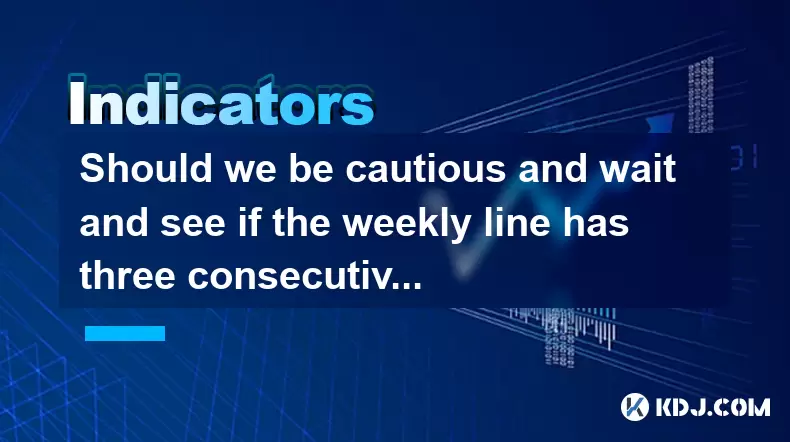
Should we be cautious and wait and see if the weekly line has three consecutive Yin lines + the daily MACD green column enlarges?
Jul 01,2025 at 12:42am
Understanding the Weekly Three Consecutive Yin Lines PatternIn technical analysis, three consecutive Yin lines on a weekly chart indicate a strong bearish trend. Each Yin line represents a week where the closing price is lower than the opening price, signaling consistent selling pressure. When this pattern appears three times in succession, it often sug...
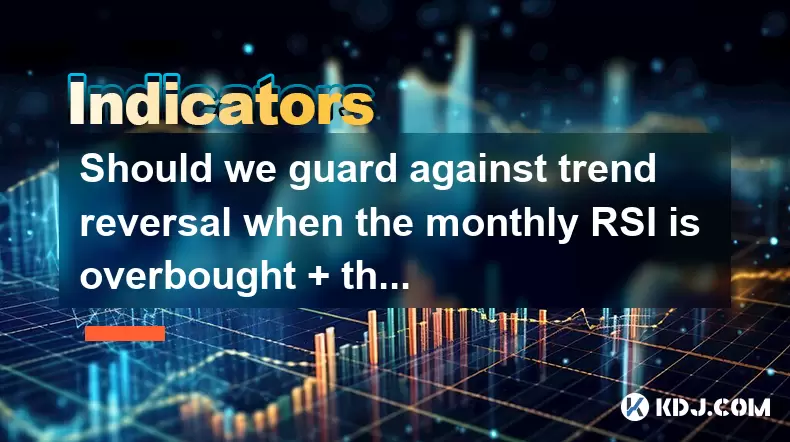
Should we guard against trend reversal when the monthly RSI is overbought + the weekly line has a long upper shadow?
Jun 30,2025 at 11:35pm
Understanding RSI Overbought Conditions in CryptocurrencyThe Relative Strength Index (RSI) is a momentum oscillator commonly used in technical analysis to identify overbought or oversold conditions in an asset. When the monthly RSI of a cryptocurrency reaches above 70, it is generally considered overbought, suggesting that the asset may be due for a pul...
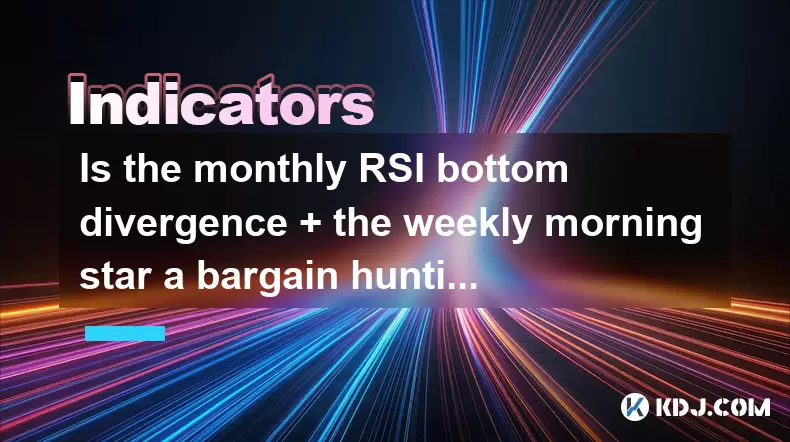
Is the monthly RSI bottom divergence + the weekly morning star a bargain hunting opportunity?
Jun 30,2025 at 09:57pm
Understanding RSI Bottom Divergence in Monthly TimeframesThe Relative Strength Index (RSI) is a momentum oscillator commonly used to identify overbought or oversold conditions in the market. When traders refer to a monthly RSI bottom divergence, they're observing a situation where the price makes a lower low, but the RSI makes a higher low on the monthl...
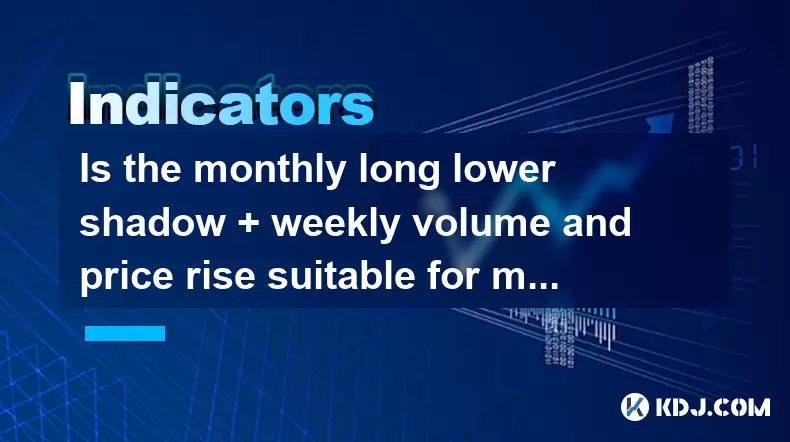
Is the monthly long lower shadow + weekly volume and price rise suitable for mid-term layout?
Jul 01,2025 at 01:29am
Understanding the Monthly Long Lower Shadow PatternA monthly long lower shadow candlestick pattern occurs when the price of a cryptocurrency drops significantly during the month but then rebounds to close near or above the opening price. This creates a candle with a long wick below and a relatively small body. In technical analysis, this pattern is ofte...
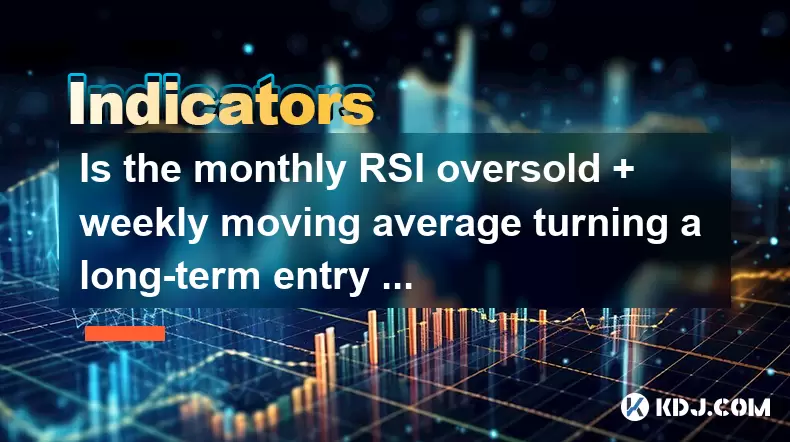
Is the monthly RSI oversold + weekly moving average turning a long-term entry signal?
Jun 30,2025 at 11:42pm
Understanding RSI and Its Role in Cryptocurrency TradingThe Relative Strength Index (RSI) is a momentum oscillator commonly used by traders to identify overbought or oversold conditions in the market. In the context of cryptocurrency, where volatility reigns supreme, understanding how RSI behaves on different timeframes becomes crucial. When the monthly...

Can I add positions if the daily line breaks through the descending channel + the 30-minute moving average is in a bullish arrangement?
Jun 30,2025 at 11:00pm
Understanding the Descending Channel BreakoutWhen a daily line breaks through a descending channel, it indicates a potential shift in market sentiment from bearish to bullish. A descending channel is formed by drawing two parallel trendlines, where the upper trendline connects the lower highs and the lower trendline connects the lower lows. A breakout o...

Should we be cautious and wait and see if the weekly line has three consecutive Yin lines + the daily MACD green column enlarges?
Jul 01,2025 at 12:42am
Understanding the Weekly Three Consecutive Yin Lines PatternIn technical analysis, three consecutive Yin lines on a weekly chart indicate a strong bearish trend. Each Yin line represents a week where the closing price is lower than the opening price, signaling consistent selling pressure. When this pattern appears three times in succession, it often sug...

Should we guard against trend reversal when the monthly RSI is overbought + the weekly line has a long upper shadow?
Jun 30,2025 at 11:35pm
Understanding RSI Overbought Conditions in CryptocurrencyThe Relative Strength Index (RSI) is a momentum oscillator commonly used in technical analysis to identify overbought or oversold conditions in an asset. When the monthly RSI of a cryptocurrency reaches above 70, it is generally considered overbought, suggesting that the asset may be due for a pul...

Is the monthly RSI bottom divergence + the weekly morning star a bargain hunting opportunity?
Jun 30,2025 at 09:57pm
Understanding RSI Bottom Divergence in Monthly TimeframesThe Relative Strength Index (RSI) is a momentum oscillator commonly used to identify overbought or oversold conditions in the market. When traders refer to a monthly RSI bottom divergence, they're observing a situation where the price makes a lower low, but the RSI makes a higher low on the monthl...

Is the monthly long lower shadow + weekly volume and price rise suitable for mid-term layout?
Jul 01,2025 at 01:29am
Understanding the Monthly Long Lower Shadow PatternA monthly long lower shadow candlestick pattern occurs when the price of a cryptocurrency drops significantly during the month but then rebounds to close near or above the opening price. This creates a candle with a long wick below and a relatively small body. In technical analysis, this pattern is ofte...

Is the monthly RSI oversold + weekly moving average turning a long-term entry signal?
Jun 30,2025 at 11:42pm
Understanding RSI and Its Role in Cryptocurrency TradingThe Relative Strength Index (RSI) is a momentum oscillator commonly used by traders to identify overbought or oversold conditions in the market. In the context of cryptocurrency, where volatility reigns supreme, understanding how RSI behaves on different timeframes becomes crucial. When the monthly...
See all articles

























































































